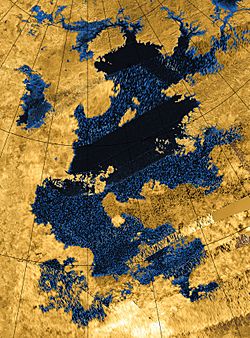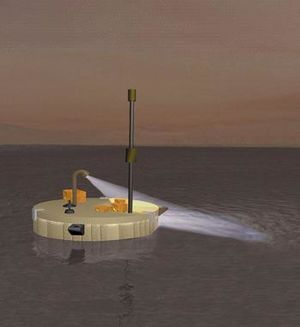Kraken Mare facts for kids

False-color mosaic of synthetic aperture radar images showing all of Kraken Mare. The large island Mayda Insula is left of top center, and Jingpo Lacus is at upper left. A portion of Ligeia Mare enters the view at top right.
|
|
| Feature type | Mare |
|---|---|
| Coordinates | 68°N 310°W / 68°N 310°W |
| Diameter | 1,170 km |
| Eponym | Kraken |
Kraken Mare is the biggest known lake or sea on Titan, which is one of Saturn's moons. Scientists found it in 2007 using the Cassini space probe. It was named in 2008 after the Kraken, a giant sea monster from old legends.
Contents
What is Kraken Mare?
Kraken Mare is huge! It covers about 400,000 square kilometers. This makes it the largest body of liquid in Titan's northern area. To give you an idea, it's even bigger than the Caspian Sea on Earth.
Scientists believe Kraken Mare is mostly made of liquid hydrocarbons, like methane. Think of it as a giant lake of natural gas, but in liquid form because Titan is super cold! Radar images from the Cassini probe helped confirm this. The deepest parts of Kraken Mare seem to be around 160 meters deep.
Is there an island in Kraken Mare?
Yes, there is an island inside Kraken Mare called Mayda Insula. It's like a piece of land sticking out of this big alien sea. Kraken Mare might also be connected to another large sea on Titan, called Ligeia Mare.
What are the currents like?
There's a narrow part of Kraken Mare, similar to the Strait of Gibraltar on Earth, that scientists call Seldon Fretum. It's also known as the 'Throat of Kraken'. This narrow spot might have strong currents.
Titan's orbit around Saturn isn't perfectly round, which can cause tides in Kraken Mare. These tides could be about 1 meter high. When the tides move through the 'Throat of Kraken', they might create currents as fast as 0.5 meters per second. This could even lead to whirlpools!
Could we visit Kraken Mare?
Scientists have thought about sending a special probe to Kraken Mare. This mission, called the Titan Saturn System Mission, would involve a probe splashing down on the sea. The goal would be to study what the liquid is made of, how deep it is, and many other interesting things about this unique alien sea.
See also
 In Spanish: Mar del Kraken para niños
In Spanish: Mar del Kraken para niños


